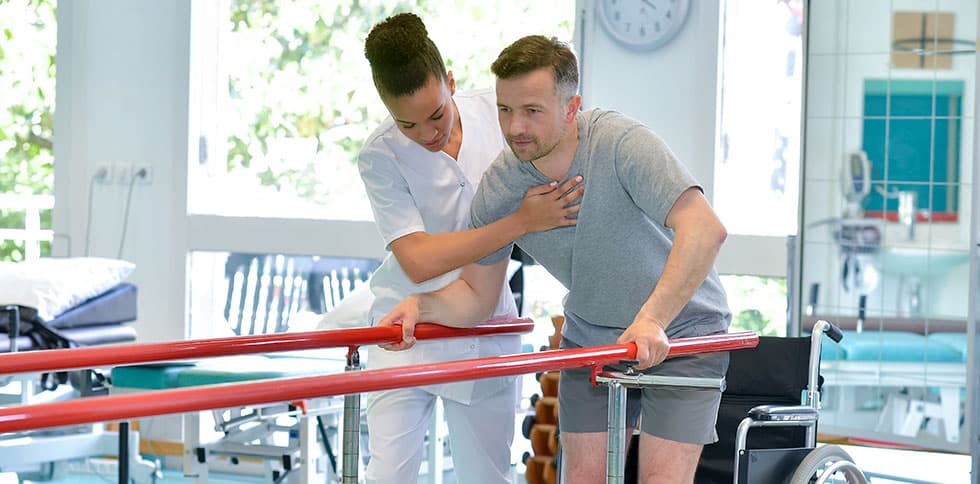Common Causes of Spinal Cord Injuries in NYC
New York City’s fast pace and density mean spinal cord injuries (SCIs) often stem from serious accidents. Car crashes rank among the top causes. A high-speed collision on FDR Drive or the BQE can compress, fracture, or sever the spinal cord. Motorcyclists and bicyclists also face heightened risks because of limited protection.
Pedestrian accidents, sadly frequent in Manhattan, Brooklyn, and Queens, may also result in catastrophic spinal damage when struck by a motor vehicle.
Construction accidents are another major source. New York’s skyline depends on workers who often labor at dangerous heights on scaffolds and ladders. A fall from even a few stories can cause a spinal fracture. Under New York Labor Law §240, commonly called the “Scaffold Law,” contractors and owners hold strict liability when safety devices fail on elevated work sites.
Other causes include slip and falls on unsafe property, violent assaults, and sports injuries. Each incident leaves behind trauma that ripples through every aspect of life for survivors and their families.
Types of Spinal Cord Injuries and Their Impact
The location and severity of a spinal cord injury determine the loss of movement and sensation. Complete injuries cut off nerve signals below the injury level, often leading to paralysis. Quadriplegia involves loss of use of both arms and legs, while paraplegia affects the lower body. Incomplete injuries allow partial function, but even “milder” injuries can mean chronic pain, muscle weakness, or bladder and bowel difficulties.
Beyond mobility, SCIs often bring secondary conditions: respiratory issues, blood clots, and infections. Emotional impacts, including depression and anxiety, can be overwhelming. The ripple effect extends to families who must adapt homes, provide day-to-day care, and navigate disability systems.
The Spinal Cord Injury Recovery Process and Resources
Recovery is not a straight line. After emergency surgery or stabilization, many patients spend weeks in inpatient rehabilitation facilities. They must relearn basic skills like sitting, balancing, or transferring from bed to wheelchair. Physical therapy helps strengthen muscles. Occupational therapy teaches adaptive methods for everyday tasks. Vocational therapy may assist in regaining workplace independence.
In New York, survivors can access local hospitals, rehab centers, and nonprofit-supported programs. The state’s Office for People With Developmental Disabilities (OPWDD) and the New York State Department of Health also provide services for long-term support. Every stage of recovery requires persistence but also access to the right network of resources.
Rehabilitation and Therapy Centers in New York
New York hosts world-renowned rehabilitation facilities. Mount Sinai Rehabilitation Center in Manhattan specializes in neurological recovery. NYU Langone’s Rusk Rehabilitation provides inpatient and outpatient SCI care, including robotics-assisted therapy. Burke Rehabilitation Hospital in White Plains offers one of the nation’s largest inpatient rehab programs, attracting patients from all over New York City and beyond.
These centers provide services ranging from mobility training to psychological support. When evaluating therapy options, patients should consider staff experience with SCI-specific care, available technologies, and integration of family training programs.
Medical Specialists and Hospitals for SCI Patients
In addition to rehabilitation, certain New York hospitals lead in SCI-related neurosurgery and acute care. NewYork-Presbyterian and Hospital for Special Surgery both feature spinal injury specialists. These hospitals house trauma centers equipped to treat spinal fractures and swelling immediately after accidents. Securing expert surgical and neurological care early can improve long-term function.
Support Groups and Community Programs in NYC
Connecting with others reduces isolation. The Reeve Foundation supports regional peer mentoring. Local organizations like the Triumph of the Human Spirit Spinal Cord Injury Project in NYC provide community events and education. The United Spinal Association, founded in New York, connects survivors with advocacy tools and peer networks.
Financial Assistance & Disability Benefits in New York
Medical bills, adaptive equipment, and loss of income create crushing financial strain. New Yorkers with SCIs may qualify for Social Security Disability Insurance (SSDI) or Supplemental Security Income (SSI). The New York State Office of Temporary and Disability Assistance helps with applying for these benefits. Medicaid provides critical secondary coverage for many survivors, especially given the high costs of ongoing care.
The state’s Traumatic Brain Injury and Nursing Home Transition and Diversion waivers sometimes extend to SCI survivors, offering in-home services instead of long-term institutionalization. Understanding available financial assistance can open doors to wider recovery options.
Housing, Accessibility, and Transportation Resources
SCI survivors often need home modifications: ramps, widened doorways, roll-in showers, and accessible kitchen layouts. New York State Homes and Community Renewal offers grants and loans for modifications. Nonprofit organizations also provide wheelchair ramp installations or accessibility grants. Within the city, the MTA Access-A-Ride program offers door-to-door paratransit for commuters with mobility challenges.
How to Find New York Spinal Cord Injury Resources
Questions to Ask When Evaluating Rehabilitation Centers
- Does the facility specialize in spinal cord injury treatment?
- What is the therapist-to-patient ratio?
- Does the center offer cutting-edge technologies like exoskeleton suits?
- Are family members involved in the rehabilitation plan?
- What are the inpatient and outpatient options?
Local and Statewide Directories for SCI Support
New Yorkers can use regional directories such as the New York State SCI Resource Center database. City agencies like NYC Health and local libraries also maintain updated listings of medical, psychological, and vocational support services.
Leveraging New York Nonprofits and Government Programs
Several nonprofits focus exclusively on spinal injury survivors. The United Spinal Association remains one of the strongest advocacy groups for New Yorkers. Government-backed programs, like vocational rehabilitation assistance through ACCES-VR, help survivors reenter the workforce. Programs like Open Doors, operated by the New York Association on Independent Living, provide transition support from nursing facilities to community living.
Legal Support for Spinal Cord Injury Victims in New York
How a New York Personal Injury Lawyer Can Help
The physical and financial weight of an SCI can crush families. Insurance companies will try to minimize payouts. Property owners and contractors may deny responsibility. Our lawyers step in aggressively to gather evidence, identify liable parties, and press claims under New York law. From deposing negligent drivers to invoking protections like the Labor Law’s Scaffold Law, we stay relentless in holding accountable those who caused harm.
What Compensation May Be Available in SCI Cases
New York law allows spinal cord injury victims to pursue compensation for medical expenses, rehabilitation costs, lost income, diminished future earnings, and pain and suffering. Courts also recognize the immense impact on families, who may have their own claim for loss of services. In construction accidents, third-party claims against general contractors or property owners can open additional layers of compensation beyond workers’ compensation benefits. However, the value depends on facts, available insurance, and liability determinations.
Why Choose Hecht, Kleeger & Damashek for Advocacy
Our record speaks volumes. We have secured over $850 million on behalf of injured New Yorkers. Families turn to us because our strategy blends courtroom force with personal compassion. We push relentlessly against negligent parties. We stand by you in the darkest moments, not just as lawyers, but as allies who understand how much is at stake.
Tell Us What Happened
"*" indicates required fields



